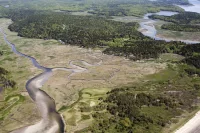
On a balmy Friday morning in mid-July, a research team of five from Bates scrambled across the slippery rocks of Cape Neddick, searching the rockweed-coated landscape for the shiny, dark, blue-purplish shellfish previously so emblematic of Maine’s beaches.
Live mussels once seemed to cling to every rock or wharf. Their shells littered patches of the shoreline and would crunch underfoot. Going barefoot felt risky.
But for decades, the number of native mussels has been dwindling. Over the past 50 years, Maine’s blue mussel populations have decreased by about 60%, according to a 2016 study from the University of California, Irvine.
The research team — Justin Baumann, an assistant professor of environmental studies, and his four Bates summer interns — had adjusted their expectations accordingly, but still, they found fewer blue mussels in the intertidal zone than anticipated.
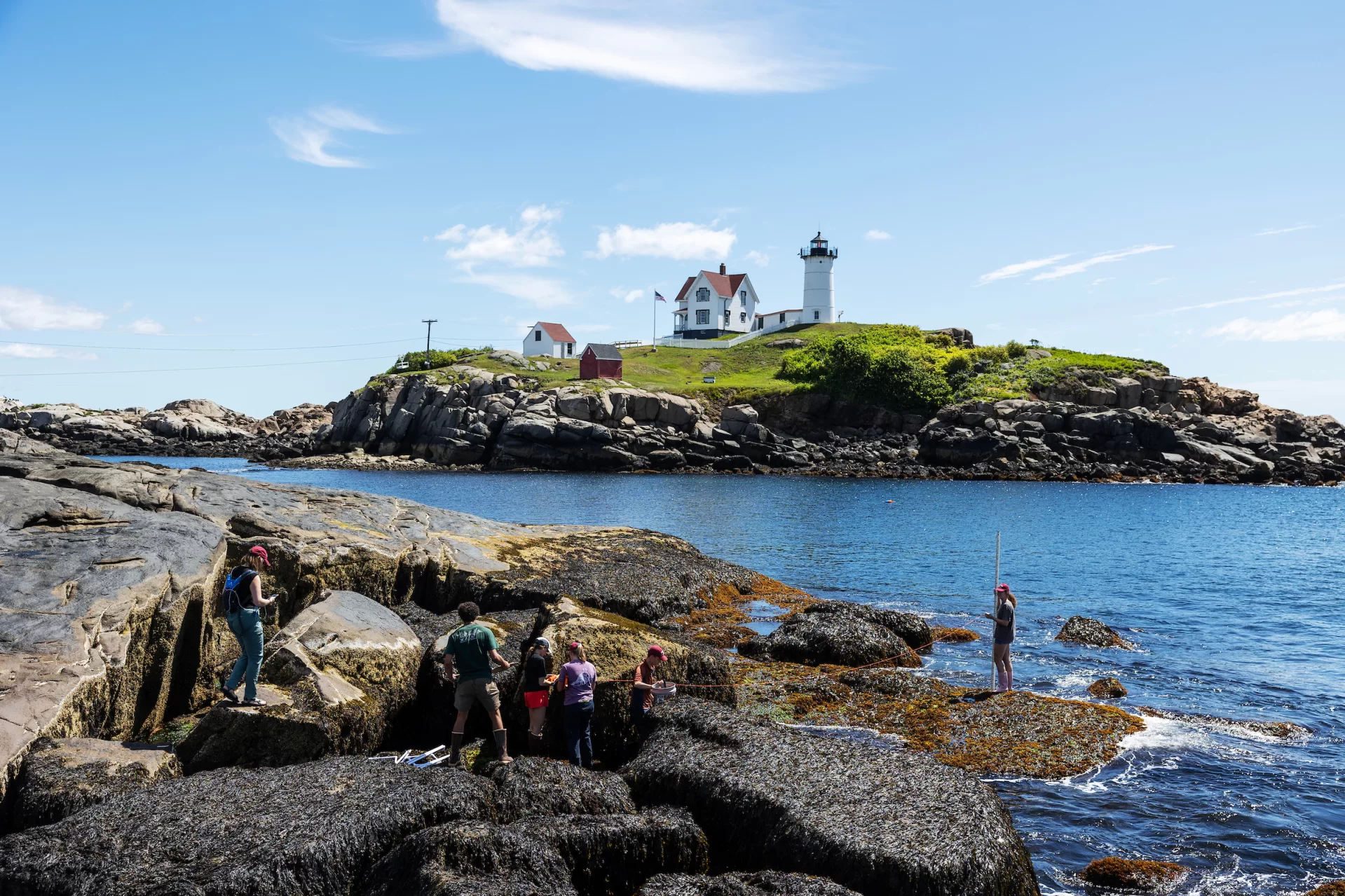
Baumann and students hope their research will offer fresh insight into the cause of this disappearance. Scientists suspect that the decrease in blue mussels is due in part to increased predation from invasive green crab populations, overfishing, ocean acidification from increasing atmospheric carbon dioxide levels, and warming waters caused by climate change.
The Gulf of Maine Research Institute is studying whether the decline is more of a retreat to colder waters, and Maine’s mussel aquaculture industry is making adjustments to the changing ecosystem. Baumann and the Bates students are approaching their research from the hypothesis that the population decline is primarily correlated with rising water temperatures in the Gulf of Maine, which is heating up about 97% faster than most ocean waters due to climate change. Ideally, their research might shed light on how the mussels could adapt to rising temperatures.
From Quoddy Head State Park to Cape Neddick, this summer Baumann and interns Amanda Power, Amanda Jenkins, Reuven Frye, and Sophie Leight, all seniors at Bates, have collected mussels and data from low and high intertidal areas, which will support the four students’ thesis projects — which Baumann is advising — and a years-long project for Baumann.
In the field, each researcher plays a key role. At Cape Neddick, Power, a biology major from Scottsdale, Ariz., and Leight, an environmental studies and religious studies double major from Easton, Md., began the day in the low intertidal zone — the part of the shoreline only exposed at the lowest point of the tide — hunting for 50 live organisms for their lab experiments before water obscured the area. Some mussels easily gave way to the collectors; a few hardy mussels, attached to rocks by strong filaments called byssal threads, required a Philips head screwdriver.
“There’s a lot of wave action here,” Power said. “They’ve got to hold on really tight to not get washed away.”
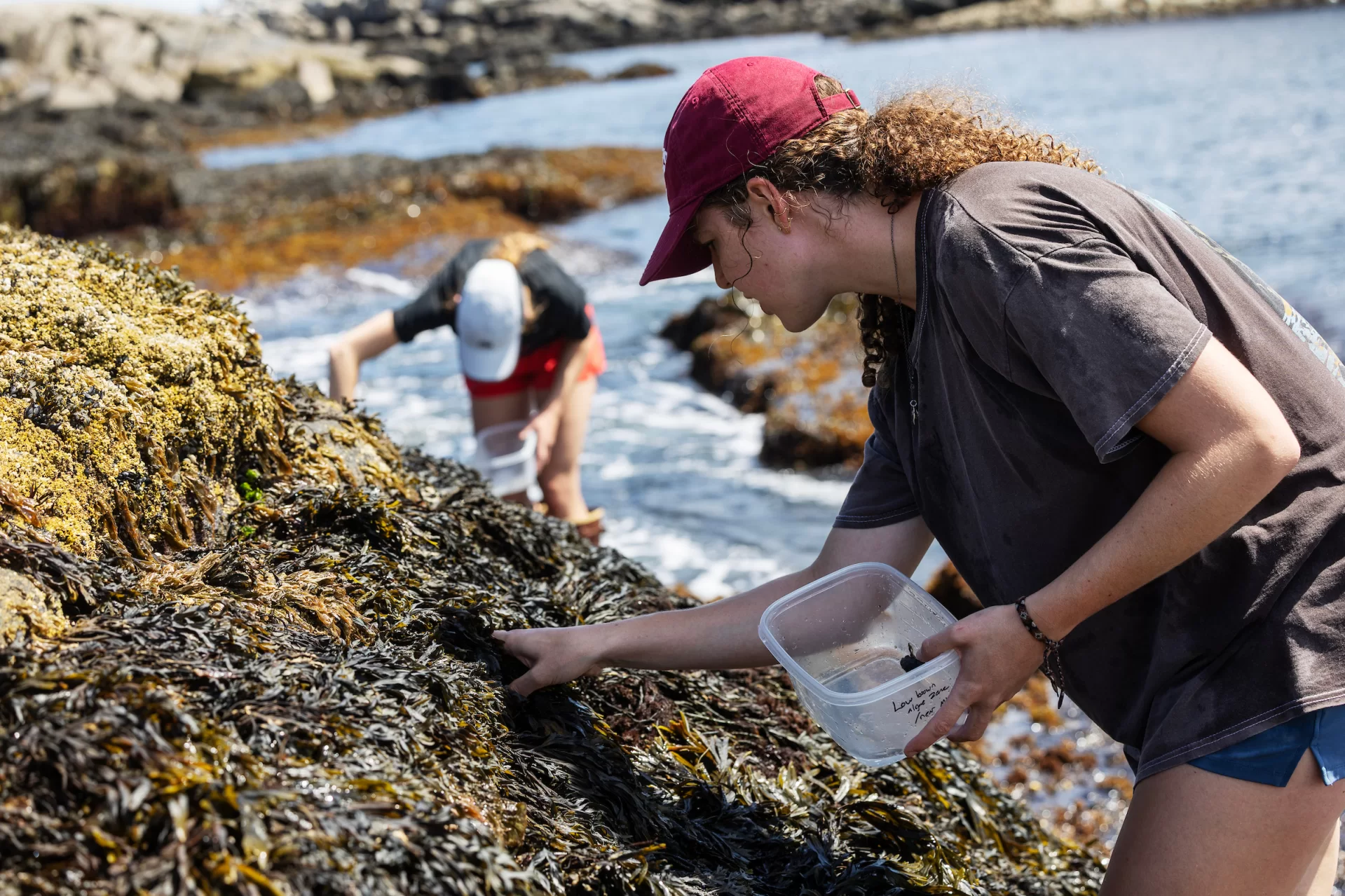
The students placed the mussels into collection containers to take back to Bates. Cooled by ocean spray, they scrambled between the water and the rocks, lapping waves filling up their boots.
“Falling and slipping around are just inevitable parts of the job,” Leight said. “But it is also fun, especially when you can make some cool discoveries while you’re searching.”
On the coast, students have found other small sea creatures interspersed between the mussels, including star fishes, sea anemones, and green crabs, the invasive, widespread predators that enjoy munching on mussels and aren’t afraid to snap at humans poking around in their homes, Power said.
“I really have enjoyed my ability to get out in the field at Bates,” Power said. “They do that really well — lab experience, field experience. You’re not just always in the classroom.”
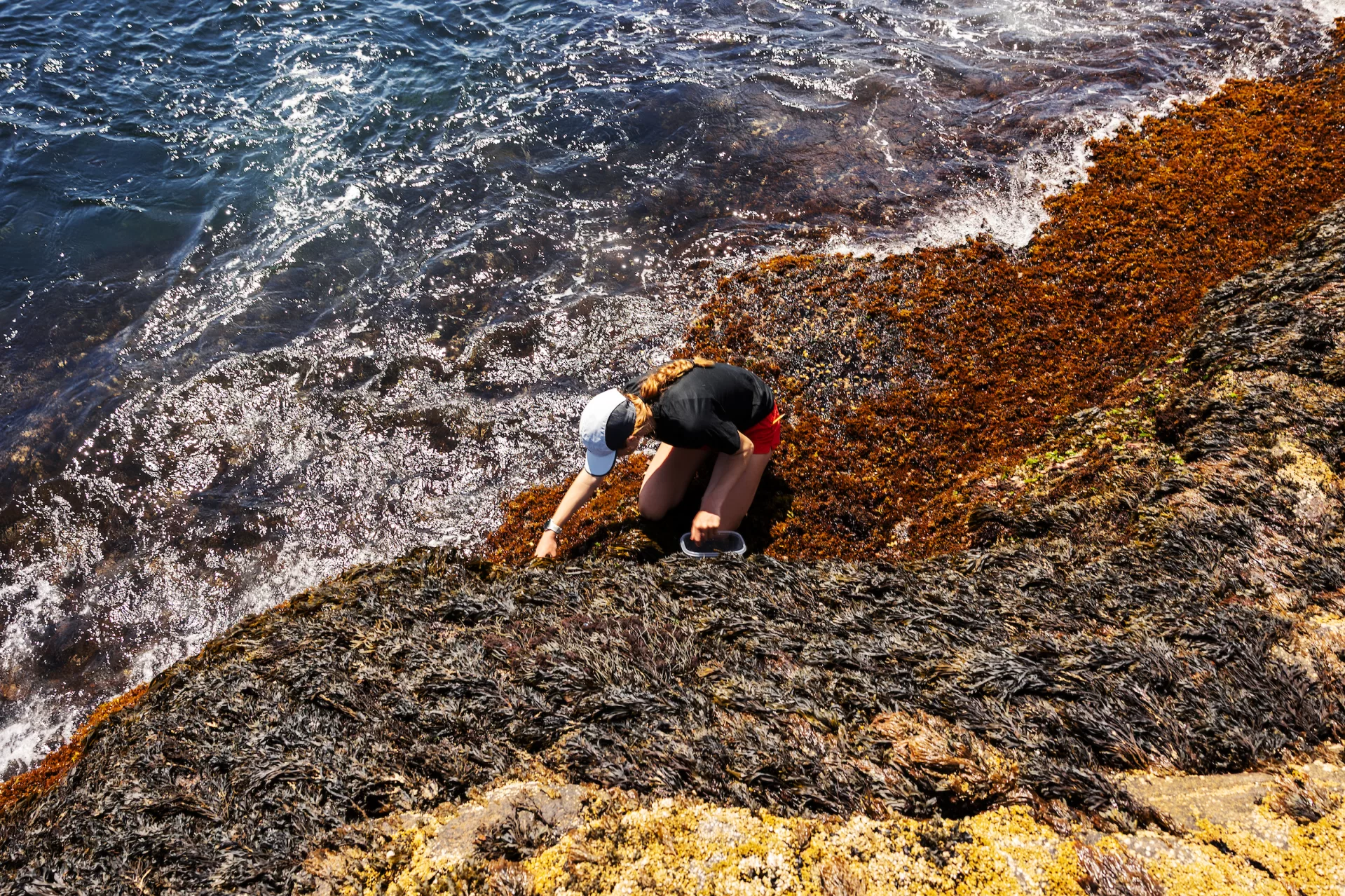
Once they collected 50 mussels, the students covered the animals with handfuls of moist rockweed, a temporary coolant to keep the animals comfortable in the containers before they’re transferred to campus.
“You want to make them feel at home and less stressed,” Leight said. “Having some moisture helps with that, especially on a sunny day.”
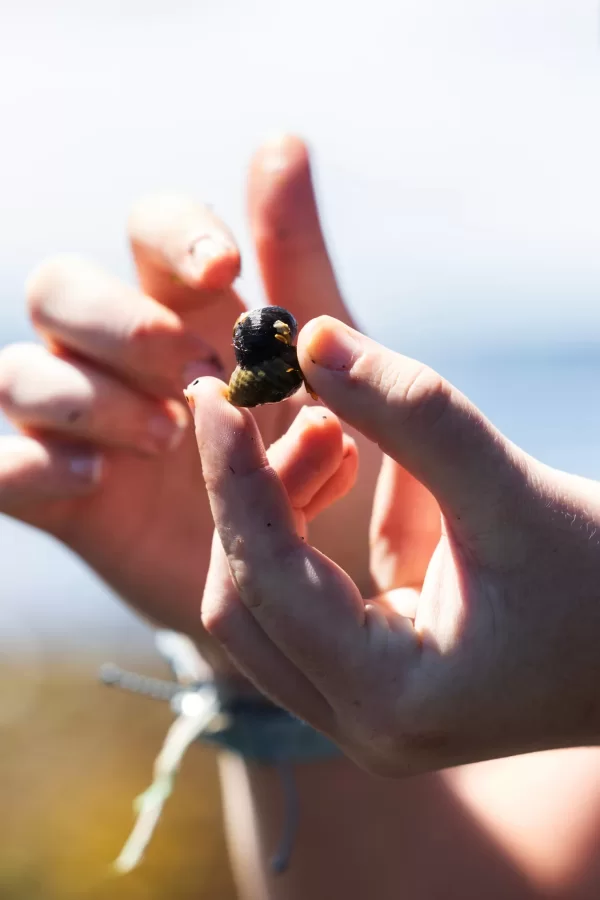
Across the rocks, Frye, an environmental studies major from Montclair, N.J., and Jenkins, a biology major from Summit, N.J., gathered data about other organisms. They placed a quadrat, a 1-by-1 meter frame, at 10 different points in the low intertidal zone, photographing and counting the organisms within the quadrat at each step. For his thesis, Frye will be analyzing the data collected from the quadrats to identify differing variables between low and high intertidal zones, aiming to characterize the environments around the blue mussels.
In the low intertidal area, diverse life abounds, from bioluminescent algae to predatory snails that suck blue mussels straight from their shells.
“It’s such a unique ecosystem,” Frye said. “It changes drastically twice a day, and it’s just so interesting to see these organisms adapt to that.”
Nearby, Baumann trotted around the quadrat, its white stark against the intertidal’s yellow and gray hues, on his way to his next field task.
“Don’t count me in your quadrat,” he joked.
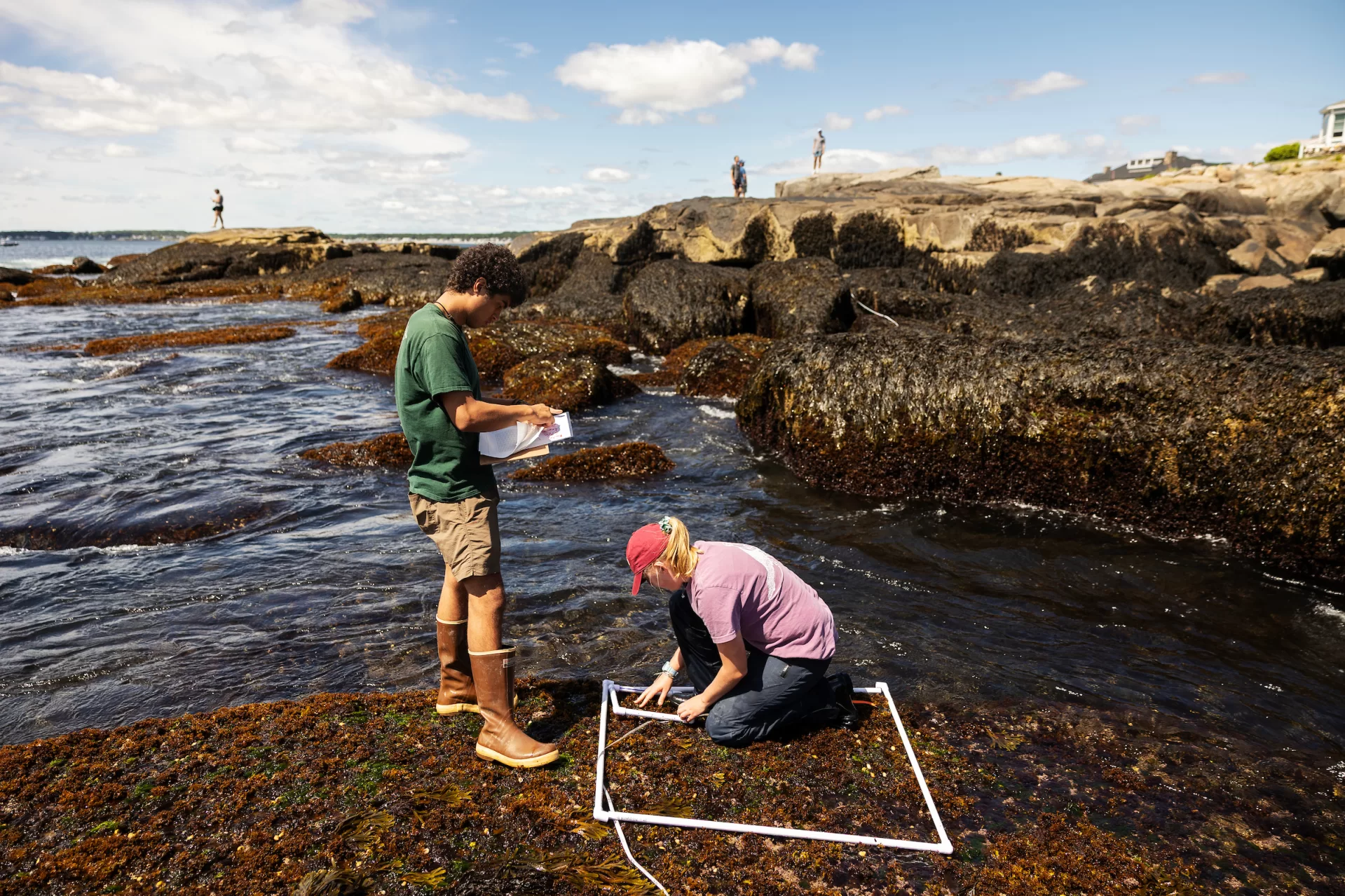
Between crashing waves, Baumann used a drill to install a sensor in a large rock to measure water temperature. The device is no larger than the size of a plastic water bottle cap and works via a tap-to-pay-like monitoring system: Baumann needs only to touch his phone to the area where the sensor is installed to collect its data. He’s placed these sensors in rocks all along the coast this summer, with full permission from the Department of Marine Resources.
Ideally, the sensors gather data on temperatures for the next 15 or 20 years. But their success is dependent on the waves’ cooperation; with that morning’s rushing tides, Baumann worried that the epoxy used to hold the sensor in place would wear off.
“The ocean doesn’t really care about what we want,” Baumann said.
He installed two more sensors at the mid- and high- intertidal zones, each marked with a plastic orange tie wrapped around a metal rock-climbing anchor, the latter an idea Baumann got from Philip Dostie, a science resource technician at Bates.
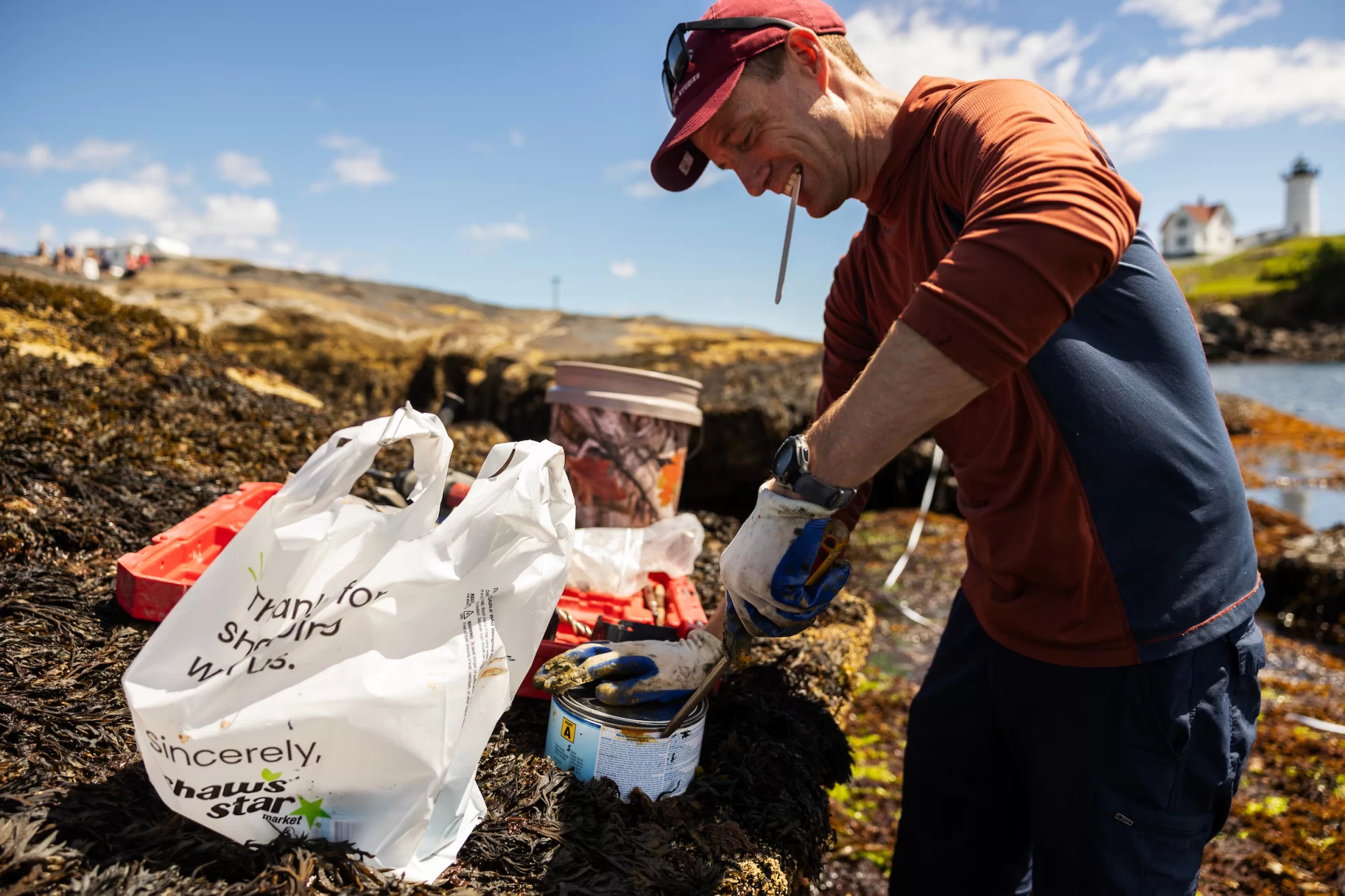
Around midday, as waters rose, the students changed roles and repeated the steps to collect the 50 more mussels and data at high tide. Here, the mussels were easier to find, though life within the white squares became more sparse, consisting mainly of barnacles and flat, black algae that a layperson could mistake for discoloration on the rocks.
After four hours in the field, the team returned to Lewiston with data and mussels in hand. The following week, they completed their final field work on Hurricane Island in Penobscot Bay before beginning their laboratory experiments.
In addition to being a staple of Maine’s marine ecosystems and seafood industry, mussels play a key role in maintaining a healthy marine environment. As filter feeders, they filter up to five gallons of seawater a day, and along with it, toxins, metals, and microplastics. Scientists can assess the health of ecosystems by measuring toxin levels in mussels.
Mussels are also foundational organisms. Like the coral in reefs or trees in a forest, mussels’ ecosystems are built around them. Their shells serve as hard substrates for other, smaller organisms to build their own homes on. “A starfish could come through here and have a great bed,” Baumann said.
Humans also take advantage of mussels; not only are the organisms an edible delicacy, but people have modeled adhesives after the super-strong byssal threads that mussels use to attach themselves to surfaces.
The animals’ disappearance would mean losing an entire layer of the intertidal ecosystem, with unknown but potentially disastrous consequences.
“I don’t know that the ecosystem is actually going to change visibly to people, but ecologically in terms of how nutrients cycle and what it looks like, it will change,” Baumann said.

Baumann wants to understand how mussels cope with the latter point and suspects that organisms respond differently to temperature changes based on their home latitudes. He chose to investigate mussels in the intertidal zone specifically because the animals already experience drastic temperature changes each day as the tide comes in and out. Their resilience may offer insight into how mussels can survive changing temperatures.
“It seems like because of the dynamic range of the ecosystem that they should have some flexibility,” Baumann says. “We think that there might be something here to how organisms can manage change really fast.”
The project is investigating this hypothesis by analyzing the temperature and ecological data collected along Maine’s coast, studying genetic differences between mussel populations living at various latitudes (i.e. the chilly waters of Quoddy Head versus the warmer waves at Cape Neddick) and different levels of the intertidal zone, measuring how mussels from different locations respond to changing water temperatures, and assessing how thermal plasticity, or an organism’s ability to adjust its tolerance for changing temperatures, varies between different mussel populations.

Though he led similar research as a visiting professor at Bowdoin, this project is Baumann’s first big foray into the world of blue mussels. His specialty is in tropical coral reef research — specifically studying how reefs react to changing temperatures from climate change.
When he relocated to Maine, Baumann wanted to pivot his research toward local ecosystems and support longstanding research on the coastline, an area vital to Maine’s economy and culture.
Maine needs researchers looking to answer questions about how climate change will affect coastal communities and ecosystems, Baumann explained, especially as many of the scientists conducting research on organisms like blue mussels retire.
“I’m thinking about how ecosystems are changing due to climate change, especially ecosystems that are coastal and close to people and important for communities and livelihoods,” Baumann said. “I think that’s the ethos of the environmental studies program, the interconnectedness of everything.”
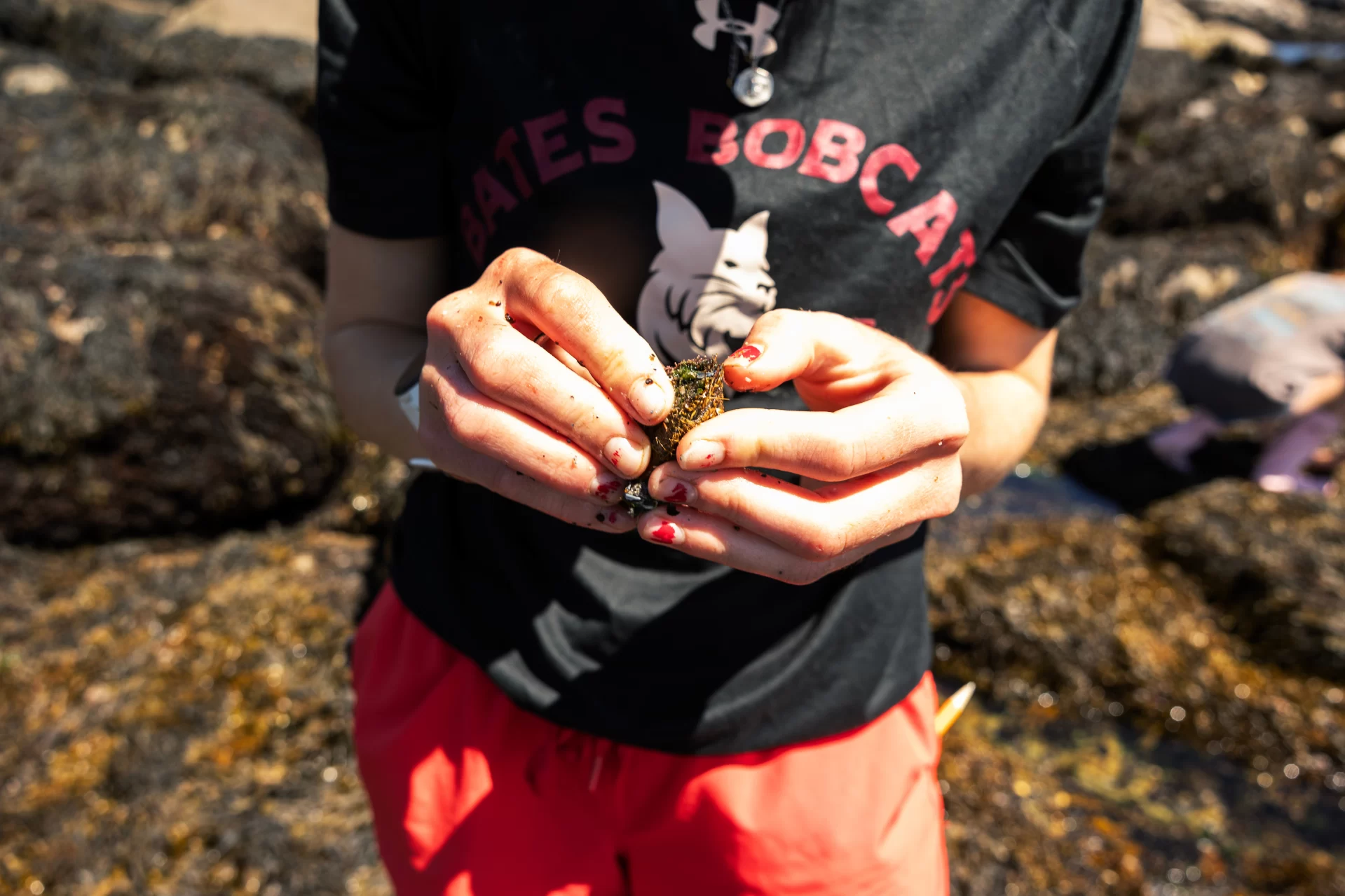
Back in Baumann’s Carnegie Hall laboratory, Leight, Power, and Jenkins conducted experiments for their thesis projects, with collaboration from Frye and Baumann. Twelve tanks of mussels line the wall of the lab’s back room, research subjects for Leight’s thermal ramping tests. During the experiments, Leight took seven mussels at a time from the tanks, placing each animal in an air-tight mason jar, all of which are then placed in a water-filled tank lined with a dishwasher rack.
Leight then slowly decreased or increased the temperature of the water surrounding the mason jars. Sensors in each jar measure the mussels’ vital signs, noting how their oxygen levels respond to the changing temperatures. She analyzed how the mussels’ responses correlate with where they were collected — from low or high intertidal areas and from the cooler waters of Quoddy Head State Park or the warmer Cape Neddick — to determine if mussels from certain areas are more resistant to temperature changes than others and identify the warmest temperatures that mussels can survive in.
For Power and Jenkins, the focus is mussel genetics. Together, they extracted DNA from the abductor muscles of mussels collected at various sites along the coast. Through an extensive purification process, the students isolated the DNA until they were left with pure genetic material.
For her thesis work, Power will be using the DNA samples to look at the genotype — an organism’s genetic makeup — of each mussel in her sample group. She’ll then analyze how mussel genotypes do or do not vary depending on which site the organisms were collected from.
“Genes can be expressed at different times in a mussel’s lifetime, but which genes they have are set in stone,” Power said. “I’m looking to see if the genetic makeup of the mussels is different across latitudes.”
Jenkins will compare DNA samples to determine if epigenetic changes, or changes in gene expressions, related to temperature regulation vary based on geographic location. She hypothesizes that mussels from warmer waters will have more epigenetic changes, which would allow them to withstand changing temperatures. “I’m seeing if their genome and those DNA processes can keep up with the warming temperatures in Maine, or if there’s an absolute limit where they can’t do anything,” Jenkins said.
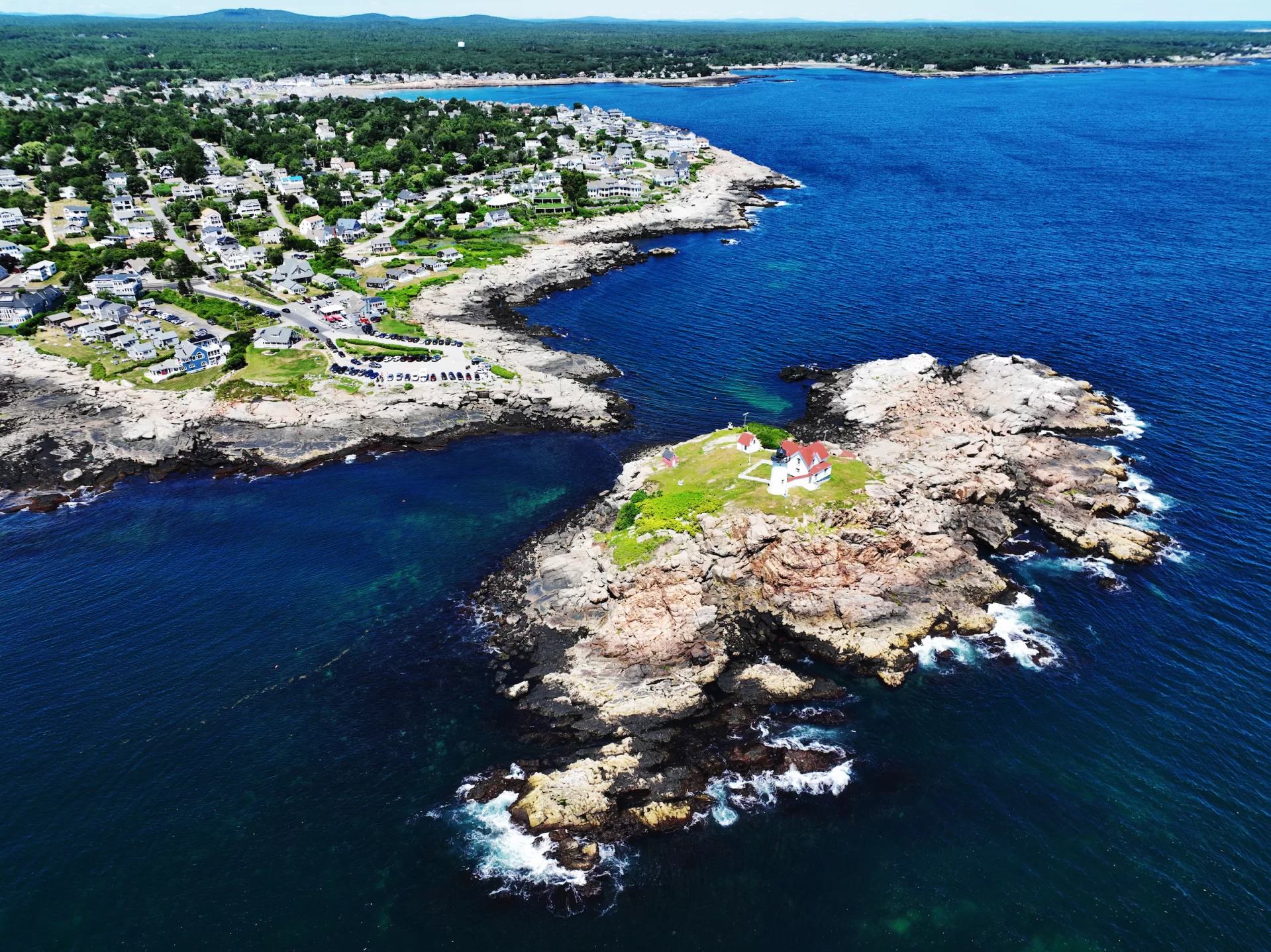
Conducting collaborative research, students learn how to work with others and support each other.
“There’s more flexibility in working together,” Baumann said. “You build a real strong sense of camaraderie, and you also can share knowledge and work on each other’s projects. Each one of them is in charge of their own project, but all four of them are working together toward one common goal.”
Baumann wanted to be a professor at a small liberal arts school like Bates largely because of the opportunity to work closely with small groups of students. While guiding students through research, he’s motivated by mentorship and helping the budding scientists carve out their career paths.
“It’s a chance for me to help them really figure out what they’re trying to do next. And that’s the whole reason I’m here,” Bauman said. “It’s about helping students get the training that they need to go on and do whatever it is they want to do with their life. That’s the value.”
The mussel researchers have gotten to know each other well, deepening existing friendships and creating new connections through hours beneath the sun and in the lab. Whether they’re handling live animals, taking measurements, or refilling aquarium tanks, the students step up for each other.
“I love working with my friends,” Power said.
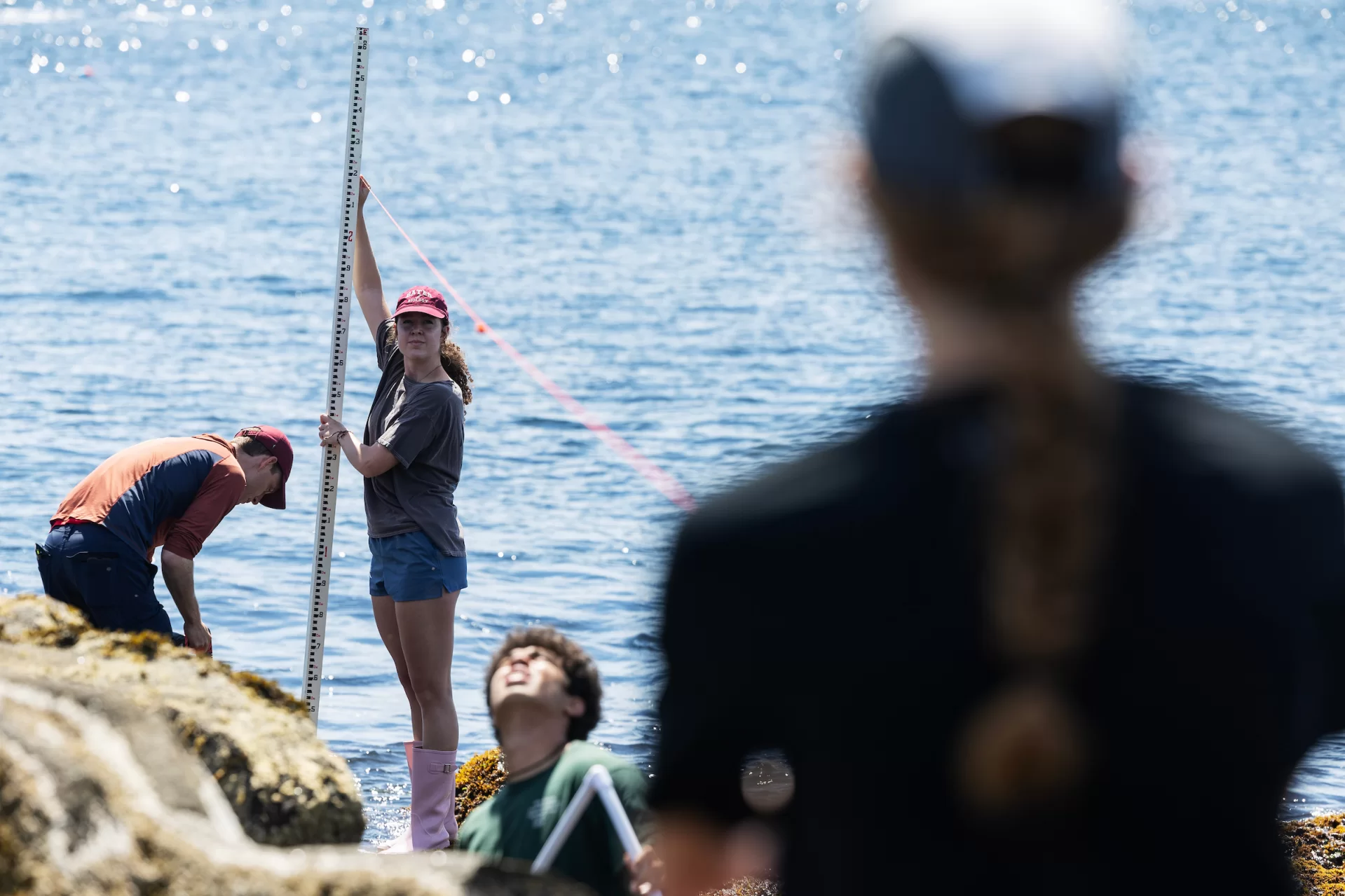
For these budding scientists, research on the coast is a manifestation of childhood passions, and all four hope to pursue careers in marine science or conservation.
“I grew up watching Our Planet, and I’ve probably seen every single ocean documentary out there,” Jenkins said. “It was a childlike wonder that has developed and matured into college and actual career paths forward.”
Frye first told his parents that he would become a marine biologist when he was 10 years old and has followed through with his promise to work alongside marine animals: He spent last fall studying in Croatia and working with dolphins and sea turtles. The mysterious allure of the blue depths and the opportunity for discovery keeps him hooked.
“We don’t know much about the ocean,” Frye said. “We know very little, and we’re learning more each day.”
This summer’s research was Leight’s second time working with mussels, if you count waitressing at a hometown restaurant that served an unforgettable mussel dish.
“The bowls that it was in were made to spill,” Leight said. “You would be carrying them and then the broth from the dish would just be all over you. That’s my number one memory of mussels.”
Leight hopes to pursue a career, perhaps in nonprofit or policy work, that combines her dual interests in religious and environmental studies, whose intersection she learned from her parents — one a scientist with NOAA, the other an Episcopal priest.
“I grew up in a household where science and religion were main topics of discussion and very intertwined with each other,” Leight said. “That’s not something I felt like I could let go when I went to Bates.”
With the lab work completed, the quartet will split up to write their respective theses over the coming months. And Baumann will settle in for what will hopefully be a couple decades of ocean and mussel measurements, each data point bringing him one step closer to uncovering what is ailing Maine’s iconic blue shellfish.
Faculty Featured

Justin H. Baumann
Assistant Professor of Environmental Studies

